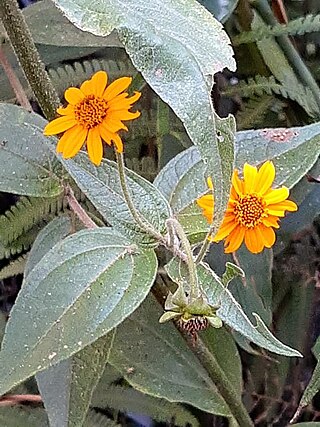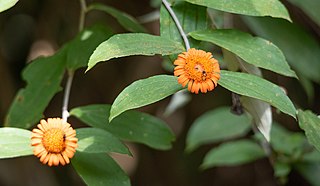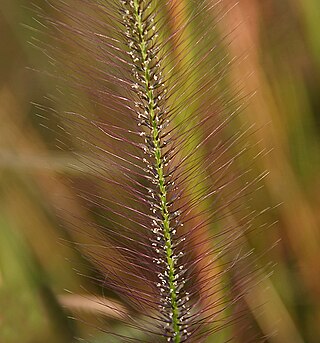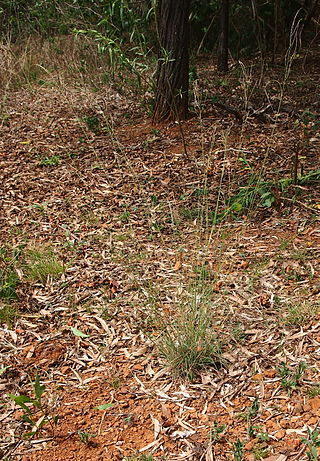
Asteraceae is a large family of flowering plants that consists of over 32,000 known species in over 1,900 genera within the order Asterales. The number of species in Asteraceae is rivaled only by the Orchidaceae, and which is the larger family is unclear as the quantity of extant species in each family is unknown. The Asteraceae were first described in the year 1740 and given the original name Compositae. The family is commonly known as the aster, daisy, composite, or sunflower family.

Dahlia is a genus of bushy, tuberous, herbaceous perennial plants native to Mexico and Central America. As a member of the Asteraceae family of dicotyledonous plants, its relatives include the sunflower, daisy, chrysanthemum, and zinnia. There are 49 species of dahlia, with flowers in almost every hue, with hybrids commonly grown as garden plants.
Peak Range is a small national park in Central Queensland, Australia, 760 km northwest of Brisbane. It is located in the Brigalow Belt bioregion.

Jacobaea is a genus of flowering plants in the tribe Senecioneae and the family Asteraceae. Its members used to be placed in the genus Senecio, but have been separated into the segregate genus Jacobaea on the basis of molecular phylogenetics in order to maintain genera that are monophyletic.

Aetheolaena is a genus of flowering plants in the aster family, Asteraceae.

Elaphandra is a genus of flowering plants in the family Asteraceae.
Elaphandra retroflexa is a species of flowering plant in the family Asteraceae. It is found only in Ecuador. Its natural habitat is subtropical or tropical dry forests. It is threatened by habitat loss.

Lycoseris is a genus of Central and South American flowering plants in the family Asteraceae.
Scalesia retroflexa is a species of flowering plant in the family Asteraceae. It is found only in the Galápagos Islands of Ecuador. It is threatened by habitat loss.

Rutidosis is a genus of Australian annual and perennial herbs in the tribe Gnaphalieae within the family Asteraceae.
Xerochloa is a genus of Australian and Southeast Asian plants in the grass family.

Perotis is a genus of Asian, African, and Australian plants in the grass family.
Pheidochloa is a genus of Australian and Papuasian plants in the grass family.

Leptochloa is a widespread genus of Asian, African, Australian, and American plants in the grass family.
Acomis is a genus of flowering plants in the family Asteraceae described as a genus in 1867. The entire genus is endemic to Australia. It was first described and published in Fragm. Vol.2 on page 89 in 1860.

Glossocardia is a genus of flowering plants in the daisy family. It is native to Asia and Australia.

Cymbonotus lawsonianus, commonly known as bears ear, is a species of small shrub in the family Asteraceae from southeastern Australia. It has been described as Arctotis lawsoniana. It is one of three species in the small genus Cymbonotus. It was named in honour of the explorer William Lawson.

Cystophora retroflexa is a brown alga species in the genus Cystophora. It found is found off the coasts of New Zealand and Australia. It is the type species of the genus. Prefers more sheltered environments compared to other Cystophora species, often found in sheltered reefs from 0 to 12 m in depth.

Symphyotrichum patens, commonly known as late purple aster or spreading aster, is a perennial, herbaceous plant found in the eastern United States.
Trioncinia patens is a species of flowering plant in the family Asteraceae. It is endemic to Queensland.












